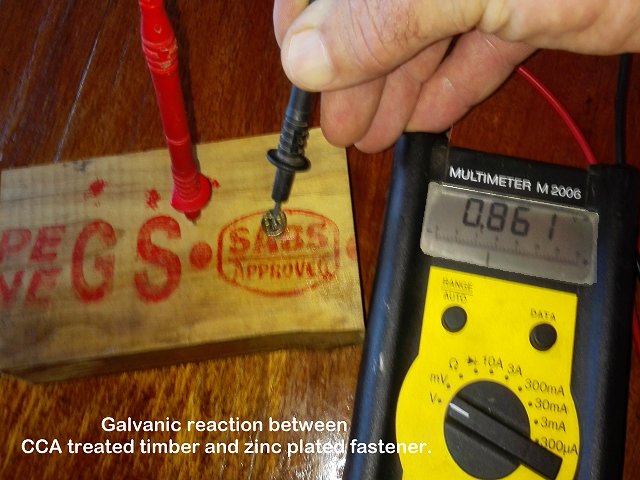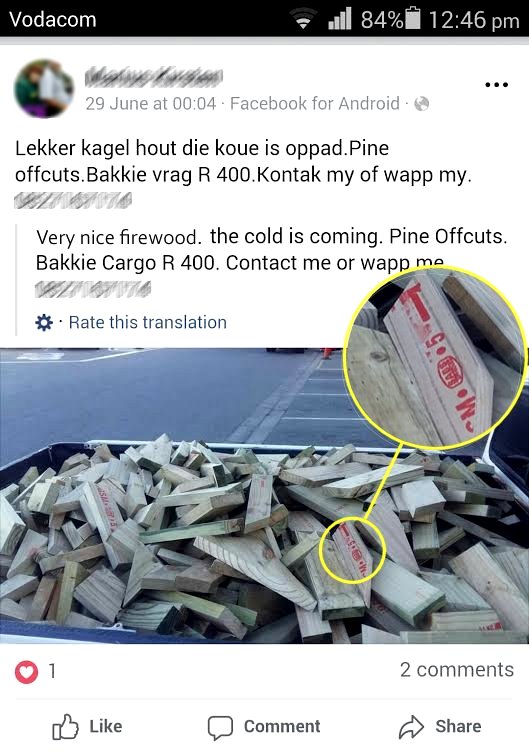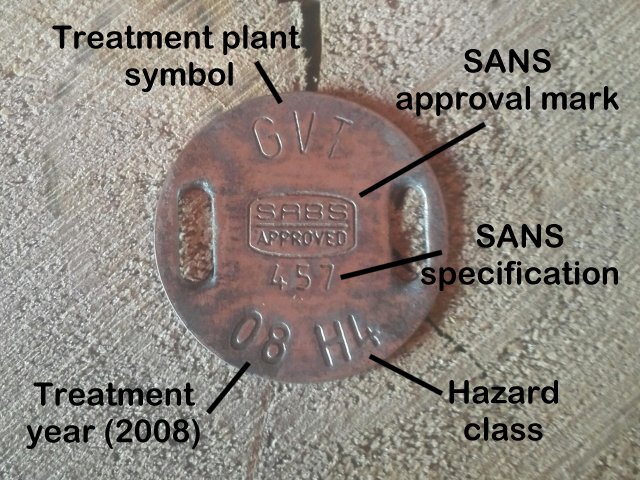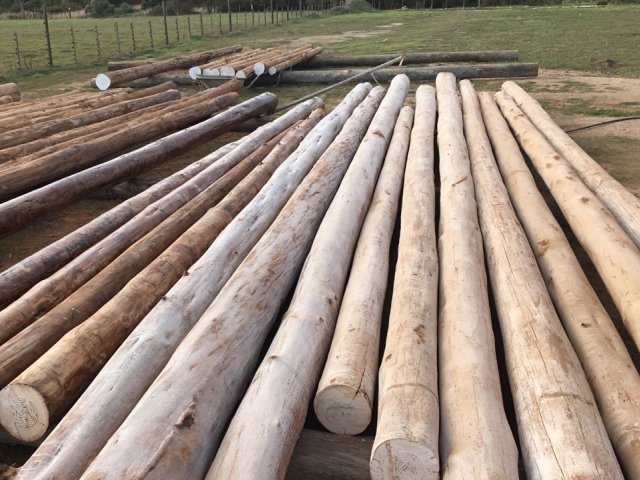Timber is treated according to the hazards to which it will be exposed
Before we launch into treated timber, I would like you to be aware that there are naturally durable timbers available which do not require toxic timber treatment.
A word of advice: I believe that treating non durable timber is essential, you are protecting your investment, it is a fact, borers eat some types of timber, however, we can successfully treat using Borates, which do not present a health hazard to us.
We treat timber to give it a longer lifespan.
There are effective and non-toxic ways to protect your log home, and give it more value, all of which is covered in detail on the course.
Some timber needs protection from wood boring beetles and rot. This depends on the circumstances, where and how the timber is used, species, location, climate, etc.
My favorite Eucalyptus timber heartwood is naturally beetle resistant, therefore, none of the sawn board timber (floor boards, etc.) in my home requires treatment.
We call this 'hazard class'.
Click here for a hazard class chart
Let me very briefly explain:
If the timber is to be used indoors, not in ground contact, it is considered as a low hazard and and would fall into hazard class 1, or H1.
If it is outdoors, in ground contact (fence poles, etc), this is a higher hazard, the treatment is more 'heavy duty' is referred to as hazard class 4, or H4.
The most hectic environment for timber is the ocean, the marine borers are very active, this is considered the highest hazard class - H6.
It is not necessary to treat your log home to H6 - unless of course you are building Noah's ark.
Some timber does not require any treatment, this is discussed in class.

Personally, I do not believe in exposing myself or my family to any potentially harmful chemicals. I prefer to take a precautionary approach and I urge you to do the same.
In South Africa, construction timber must be treated according SANS 10005 'The preservative treatment of timber'.
The copper which is impregnated into the timber with several of the preservative treatments has a galvanic reaction with galvanized metal fasteners, (screws, nails, brackets, etc), this causes them to corrode rapidly. If your house is built out CCA or ACQ treated timber, you may have a problem in the future when your house falls apart due to failure of the fasteners.

How long will it last? A galvanic reaction occurs between the copper in CCA treated timber and the zinc plating on the screw (you have created an approximately 0.8 volt battery). When this occurs, the copper in the timber always wins and the fastener always loses.
Get the full tech here.
Moisture is required and acts as an electrolyte. (readily available on an exposed deck each time it rains) CCA treatment is being phased out in many places and is often replaced by ACQ, it is less toxic but has a severe corrosion problem.
My opinion
Many of these treatments are so toxic that the treated timber should not be sold to the unsuspecting public without warnings and documentation on how one should work with, use and dispose of, in order that we all may make an informed decision, have you ever been told that timber bought in the hardware shop is toxic? How would know? What happens when it is second hand and / or has been cut into pieces and lost it's SABS treatment marking?Disposal of treated timber
- Important instructions
- Take it to the Municipal dump! Get rid of it!
-
Under no circumstances should you ever burn treated timber.

 I found this load of CCA treated timber offcuts being sold on facebook as firewood. Now it is likely that the vendor does not know that it is toxic. This is due to him being uninformed.
I found this load of CCA treated timber offcuts being sold on facebook as firewood. Now it is likely that the vendor does not know that it is toxic. This is due to him being uninformed.It appears that the Copper, Chrome and arsenic timber treatment releases toxic gases when burnt.
Combustion causes the Arsenic in the CCA treatment to become Arsine gas which is acutely toxic to yourself, your family and the environment.
Think about this...Arsine has been considered as a good compound for chemical warfare, due to the fact that it is 2.5 times heavier than air, therefore is hangs at ground level (where the rug rats are), and only takes 250 parts per million to be rapidly fatal, such as if you where burning it in your fireplace to keep warm.
It has a mild garlic or fishy smell (clearly this will be undetectable if you have recently eaten fish with extra garlic, in other words avoid extra garlic on fish meals when burning unknown firewood. Just saying..)
It does not take much... Exposure to arsine concentrations of 250 ppm is rapidly fatal: concentrations of 25–30 ppm are fatal for 30 min exposure, and concentrations of 10 ppm can be fatal at longer exposure times. Symptoms of poisoning appear after exposure to concentrations of 0.5 ppm.
It is classified as an extremely hazardous substance in the United States as defined in Section 302 of the U.S. Emergency Planning and Community Right-to-Know Act. The first signs of exposure are headaches, vertigo and nausea, followed by the symptoms of haemolytic anaemia (high levels of unconjugated bilirubin), haemoglobinuria and nephropathy.
The main route of exposure is by inhalation, although poisoning after skin contact has also been described. Arsine attacks haemoglobin in the red blood cells, causing them to be destroyed by the body.
You have been warned!
Finally,I am asking you for a favor...If you ever see anyone selling or using treated timber as firewood, inform them, reply to their facebook post, refer them to this page. At least just let them know that there is this risk.
As 'spokes medium' and facilitator to the South African timber treatment industry I request you to immediately begin a campaign of public awareness and education, warning people of the risks involved in the use and misuse of CCA treated timber, making absolutely sure that every single person who has access to, or comes into contact with the treated products which you promote is fully educated with regards to the possible toxicity of the products, how to use, not use and dispose of such products.
People who purchase a plank at a timber merchant are not made aware of the risks.
Your website has an article regarding the risks (By this, I guess that you consider yourselves covered), however it is useless to people who are not using the Internet or even aware of the need to look for it.
Are you aware that only about 60% of South African households have access to the Internet?
Are you aware that nearly 25% of South Africa's population does not cook on electricity, with wood being the main alternative?
The warnings which you provide should be at point of sale, along with each purchase of the product.
Your document Understanding the markings on treated timber implies that in some cases as few as 10% of planks are marked, how are we to know if a piece of timber is treated if 90% are unmarked? The markings need to be improved.
How are we to know in the case of offcuts where the markings have been cut off?
My suggestion, is a continuous stripe of danger symbols printed on the full length of every single plank.
The majority of public end users are not aware that SAWPA exists, you have an obligation as the timber treatment industry 'facilitator' to make the public fully aware of the risks involved so that they may make an informed choice as to how to and how not to use the treated products.
Therefore, I call upon you to immediately begin a continuous advertising campaign fully educating the public with the required information.
I expect to be voluntarily presented, at point of sale, the relevant information the next time that I purchase treated timber.
Thanking you in advance
Best regards
Roy Trembath
South African Log Home Builders Association
What is LD50?
LD50 is a way of indicating the toxicity of a substance, ie. the Lethal Dose which on average will kill 50% of the population, some people will have more tolerance and some less.
"the dose makes the poison." (anything can kill you in large enough quantities).
It is usually quoted in grams per kg body mass (g/kg), ie the bigger you are, the more you can handle.
To put it all in perspective.
Table salt (Sodium chloride) has an LD50 of 3g/kg, an average 100kg person, would require 300g for a lethal dose.
Borax has an LD50 of 2.9g/kg body mass, therefore an average 100kg person, would require 290g, ie. slightly more toxic than table salt.
Arsenic has an LD50 of 8mg/kg body mass, therefore an average 100kg person, would only require the very small amount of 0.8g. (not much at all)
Bananas have an LD50 of 5.33 bananas/kg body mass, ie. if you weigh 100kg, eating more than 533 bananas at once can be fatal (it's actually the potassium that nails you. BTW, Potassium is used for lethal injection executions).
All treated timber must be marked with a stamp or a tag.
What does this tag tell us?













 Unstoppable galvanic corrosion. ie. The fasteners corrode and your house falls apart.
Unstoppable galvanic corrosion. ie. The fasteners corrode and your house falls apart.
